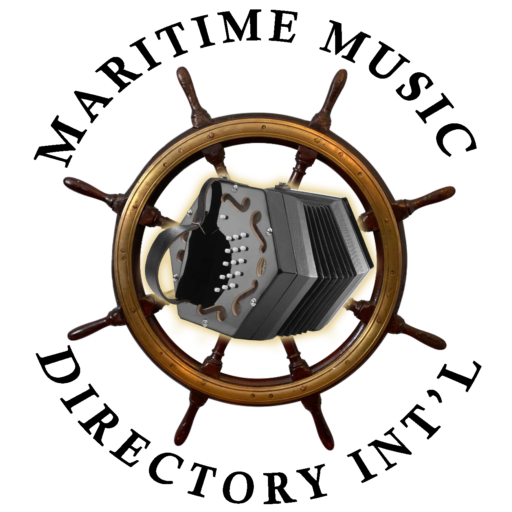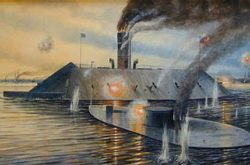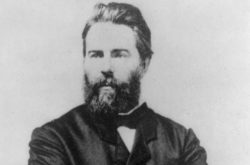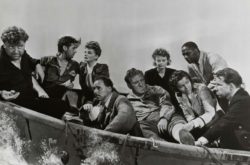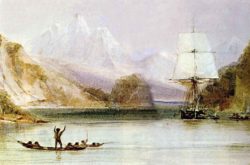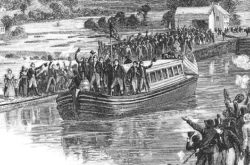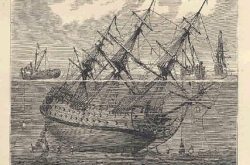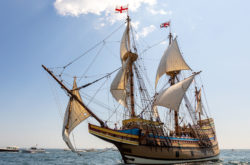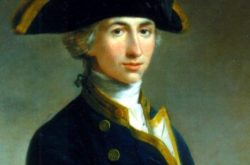USS Monitor Sinks (1862)
On December 30, 1862, the U.S.S. Monitor sinks in a storm off Cape Hatteras, North Carolina. Just nine months earlier, the ship had been part of a revolution in naval warfare when the ironclad dueled to a standstill with the C.S.S. Virginia (Merrimack)off Hampton Roads, Virginia, in one of the most famous naval battles in American history–the first time two ironclads faced each other in a naval engagement. (Note that while we try to limit these articles to feature tall ships from the Age of Sail, this development was signature to the end of the era.) Read the complete article on History.com.
Defeat Armada 1588
England Defeats Spanish Armada (1588) On July 29, 1588 England defeats the Spanish Armada Off the coast of Gravelines, France, Spain’s so-called “Invincible Armada” is defeated by an English naval force under the command of Lord Charles Howard and Sir Francis Drake. After eight hours of furious fighting, a change in wind direction prompted the Spanish to break off from the battle and retreat toward the North Sea. Its hopes of invasion crushed, the remnants of the Spanish Armada began a long and difficult journey back to Spain. Link to full article on History.com.
Herman Melville sails for the South Seas (1841)
On January 3, 1841, Herman Melville ships out on the whaler Acushnet to the South Seas. Melville was born in New York City in 1819. A childhood bout of scarlet fever permanently weakened his eyesight. He went to sea at age 19, as a cabin boy on a ship bound for Liverpool. Two years later, he sailed for the South Seas. The Acushnet anchored in Polynesia, where Melville took part in a mutiny. He was thrown in jail in Tahiti, escaped, and wandered around the South Sea islands for two years. In 1846, he published his first novel, Typee, based on his Polynesian adventures. His second book, Omoo (1847), also dealt with the region. The two novels were popular successes, although his third, Mardi Moby-Dick. The book flopped and was not recognized as a classic for many years. Click here to read the complete article on History.com.
Hollywood and the Sea:
Maritime History & Culture in Film
Register Here for the Zoom Seminar Saturday, 5 November 2022Welcome & Lecture at 11:00 AM ET, Q&A to Follow Seminars are free to attend, although we hope you will support the Series with a suggested $10 Seminar Guest donation. You won’t want to miss this special seminar with SUNY Maritime Professor Dr. John Rocco for an overview of one of his most popular courses, Hollywood and the Sea: Maritime Culture and Film. The seminar will explore Hollywood’s depiction of the maritime realms of war, work, law, and discovery, examining important themes and subjects raised by the films—the voyage narrative, American whaling, famous naval battles, slavery, World War II, and maritime crime and punishment. Dr. Rocco will guide us through the history of maritime Hollywood through the work of directors such as Buster Keaton, Michael Curtiz, Alfred Hitchcock, Howard Hawks, John Ford, Elia Kazan, Edward Dmytryk, John Huston, Francis Ford Coppola, and Steven Spielberg. For an early look at some of the films Dr. Rocco highlights in his course, see Steamboat Bill, Jr. (1928), Down to the Sea in Ships (1922), Mutiny on the Bounty (1935 and 1962), Two Years Before the Mast (1946), Moby Dick (1930 and 1956), Captain Blood (1935), The Long Voyage Home (1940), Mister Roberts (1955), The Battle of Midway (1942), They Were Expendable (1945), Action in the North Atlantic (1943), The African Queen (1951), The Caine Mutiny (1954), On the Waterfront (1954), To Have and Have Not (1944), The Breaking Point (1950), Jaws (1975), Amistad (1997), and Apocalypse Now (1979). About the SpeakerIn addition to being a well-loved professor of composition, literature, film, and other graduate studies, Dr. Rocco is also an author and the coordinator of the Maritime and Naval Studies (MNST) master’s program at SUNY Maritime. He has long been involved with digitizing years of records from Sailors’ Snug Harbor and received the SUNY Chancellor’s Award for Excellence in Teaching.
The Gold Coast King Who Fought the Might of Europe’s Slave Traders
New research reveals links between the 18th-century Ahanta leader John Canoe and the Caribbean festival Junkanoo Every Christmas, residents of the Bahamas head outdoors, crowding the streets of Nassau in celebration of Junkanoo, the country’s national festival. Tourists and locals alike applaud dancers parading in green and gold costumes to the otherworldly beat of drums, horns and bells. The most common theory paints Junkanoo’s namesake, Canoe, as a faceless victim of the transatlantic slave trade—a captive trafficked to the Bahamas, where he persuaded the English to gift enslaved Africans Christmas Day off. (Canoe is often described as a former slave trader in his own right.) The enslavers misunderstood the cultural meaning of John Canoe, instead hearing “Junkanoo.” When the holiday became a disruptive bother to the English colonial government, it dubbed them “junk anew” or “junk enough.” Read the complete Smithsonian Magazine article here.
Trafalgar Day (21 Oct 1805)
In one of the most decisive naval battles in history, a British fleet under Admiral Lord Nelson defeats a combined French and Spanish fleet at the Battle of Trafalgar, fought off the coast of Spain. At sea, Lord Nelson and the Royal Navy consistently thwarted Napoleon Bonaparte, who led France to preeminence on the European mainland. Nelson’s last and greatest victory against the French was the Battle of Trafalgar, which began after Nelson caught sight of a Franco-Spanish force of 33 ships. Preparing to engage the enemy force on October 21, Nelson divided his 27 ships into two divisions and signaled a famous message from the flagship Victory: “England expects that every man will do his duty.” Trafalgar Day is the celebration of the victory won by the Royal Navy, commanded by Vice-Admiral Horatio Nelson, over the combined French and Spanish fleets at the Battle of Trafalgar on 21 October 1805. (Nelson died from a French sharpshooter’s bullet.) You can read the full article on History.com.
Zong Slave Ship Trial
Zong slave ship trial June 22, 1783 London: Hearing arguments in the case of the Zong, a slave ship, the Chief Justice of the King’s Bench in London states that a massacre of enslaved African “was the same as if Horses had been thrown over board” on June 22, 1783. The crew of the Zong had thrown at least 142 captive Africans into the sea, but the question before the court was not who had committed this atrocity but rather whether the lost “cargo” was covered by insurance. The trial laid bare the horror and inhumanity of the Atlantic slave trade and galvanized the nascent movement to abolish it. Link to full article on History.com
Darwin Returns to Falmouth 2 Oct 1831
The British naturalist Charles Darwin returns to Falmouth, England, aboard the HMS Beagle, ending a five-year surveying expedition of the southern Atlantic and Pacific oceans. Visiting such diverse places as Brazil, the Galapagos Islands, and New Zealand, Darwin acquired an intimate knowledge of the flora, fauna, and geology of many lands. This information proved invaluable in the development of his theory of evolution, first put forth in his groundbreaking scientific work of 1859, The Origin of Species by Means of Natural Selection. Darwin’s theory argued that organisms gradually evolve through a process he called “natural selection.” In natural selection, organisms with genetic variations that suit their environment tend to propagate more descendants than organisms of the same species that lack the variation, thus influencing the overall genetic makeup of the species. His Origin of Species, the first significant work on the theory of evolution, was greeted with great interest in the scientific world but was attacked by religious leaders for its contradiction of the biblical account of creation. Read a complete article on National Geographic’s website: https://education.nationalgeographic.org/resource/hms-beagle-darwins-trip-around-world
Erie Canal Opens (1825)
The Erie Canal opens, connecting the Great Lakes with the Atlantic Ocean via the Hudson River. Governor DeWitt Clinton of New York, the driving force behind the project, led the opening ceremonies and rode the canal boat Seneca Chief from Buffalo to New York City. Work began on the waterway in August 1823. Teams of oxen plowed the ground, but for the most part the work was done by Irish diggers who had to rely on primitive tools. They were paid $10 a month, and barrels of whisky were placed along the canal route as encouragement. West of Troy, 83 canal locks were built to accommodate the 500-foot rise in elevation. After more than two years of digging, the 425-mile Erie Canal was opened on October 26, 1825, by Governor Clinton. The effect of the canal was immediate and dramatic. Settlers poured into western New York, Ohio, Michigan, Illinois, and Wisconsin. Goods were transported at one-tenth the previous fee in less than half the time. Barges of farm produce and raw materials traveled east, as manufactured goods and supplies flowed west. In nine years, tolls had paid back the cost of construction. Later enlarged and deepened, the canal survived competition from the railroads in the latter part of the 19th century. Today, the Erie Canal is used mostly by pleasure boaters, but it is still capable of accommodating heavy barges. Read the entire article on History.com.
Frobisher
Sir Martin Frobisher The advance of science appeared more dramatically in the efforts of adventurous or acquisitive spirits to explore the “great Magnet” (North America) for geographical or commercial purposes. In 1576 Sir Humphrey Gilbert published a suggestive Discourse… for a New Passage to Cataia – i.e., “Cathay,” or China – proposing a northwest sailing through or around Canada. Sir Martin Frobisher, in that year, set out with three small vessels to find such a route. One of his ships foundered, another deserted; he went ahead in the tiny twenty-five-ton Gabriel; he reached Baffin Land, but the Eskimos fought him, and he returned to England for more men and supplies. His later voyages were diverted from geography by a vain hunt for gold. Gilbert took up the quest for a northwest passage, but was drowned in the attempt (1592). The Age of Reason Begins, Will and Ariel Durant. It is commonly taught that the English ships were smaller than the Spanish. This is a misconception caused by the practice of Spanish captains to inflate the size of their ships in order to get more compensation for their use in war. At the beginning of the 16th century the English ton was equal to the Spanish tonelada, but by the time of the Armada the tonelada had shrunken to 1/2 ton. In addition, the largest ship in the battle was the 1,100 ton Triumph under the command of Frobisher. The Cavalier Compendium, Mark & Jennie Gist The English explorer Martin Frobisher created a gold fever in England in 1578 when he returned from Baffin Island with 200 tons of glittering gold ore. Great preparations were made for getting more and more gold, but it turned out that the ore was merely iron pyrite (“fool’s gold”). It was eventually crushed and used for road repair. Isaac Asimov’s Book of Facts Elizabethan Mariners
Royal George Sinks During Refitting (August 29, 1782)
Royal George sank on 29 August 1782 whilst anchored at Spithead off Portsmouth. The ship was intentionally rolled so maintenance could be performed on the hull, but the roll became unstable and out of control; the ship took on water and sank. More than 800 lives were lost, making it one of the most deadly maritime disasters in British territorial waters. Several attempts were made to raise the vessel, both for salvage and because she was a major hazard to navigation in the Solent. In 1782, Charles Spalding recovered fifteen 12-pounder guns using a diving bell of his own design. From 1834 to 1836, Charles and John Deane recovered more guns using a diving helmet they had invented. In 1839 Charles Pasley of the Royal Engineers commenced operations to break up the wreck using barrels of gunpowder. Pasley’s team recovered more guns and other items between 1839 and 1842. In 1840, they destroyed the remaining structure of the wreck in an explosion which shattered windows several miles away in Portsmouth and Gosport. Link to full article on Wikipedia.
Mayflower Departs England (16 Sept. 1620)
The Mayflower sails from Plymouth, England, bound for the New World with 102 passengers. The ship was headed for Virginia, where the colonists–half religious dissenters and half entrepreneurs–had been authorized to settle by the British crown. However, stormy weather and navigational errors forced the Mayflower off course, and on November 21 the “Pilgrims” reached Massachusetts, where they founded the first permanent European settlement in New England in late December. Read the full article on History.com.
Horatio Nelson’s Birthday (29 Sept 1758)
Born on 29 September 1758 in Burnham Thorpe, Norfolk, Horatio Nelson was the sixth of the 11 children of a clergyman. He joined the navy aged 12, on a ship commanded by a maternal uncle. He became a captain at 20, and saw service in the West Indies, Baltic and Canada. He married Frances Nisbet in 1787 in Nevis, and returned to England with his bride to spend the next five years on half-pay, frustrated at the lack of a command. When Britain entered the French Revolutionary Wars in 1793, Nelson was given command of the Agamemnon. He served in the Mediterranean, helped capture Corsica and saw battle at Calvi (where he lost the sight in his right eye). He would later lose his right arm at the Battle of Santa Cruz de Tenerife in 1797. Click here to read the full article by the BBC.
